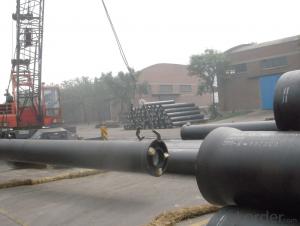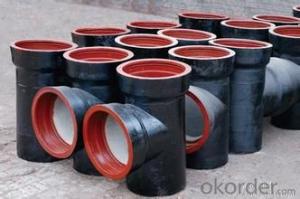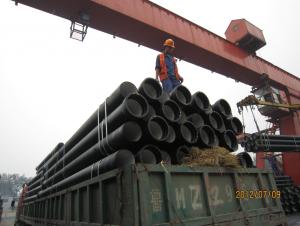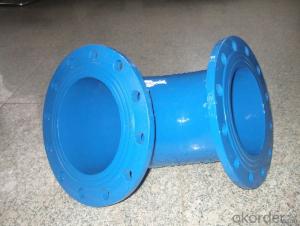DUCTILE IRON PIPES K8 DN500
- Loading Port:
- China Main Port
- Payment Terms:
- TT OR LC
- Min Order Qty:
- -
- Supply Capability:
- -
OKorder Service Pledge
OKorder Financial Service
You Might Also Like
Ductile Iron Cast Pipe is without any defects compare with tradition casting tech, which has many advantages particularly as follow:
(1) High density. In the "vertical upward casting" process, the melt iron of centre liquid column in center crystallizer is continuously feeding for volume shrinkage caused by condensation tube at outer circumference , which lead to be free of shrinkage porosity.
(2) High purity. When melt iron pouring, the mixed impurities such as gas, dross, sand grain which are lighter than melt iron could be eliminated at furnace mouth, its impossible to enter into the crystallizer through the channel, so the melt iron into the crystallizer is very pure.
(3) Strength with toughness. The cooling speed provided by continuous crystallizer is 30 times than sand casting and 5 times than centrifugal casting, and doesn't produce white iron, the eutectic cell volume of continuous cast iron is one eighth to one tenth compare with traditional cast iron. The density of graphite nodule in ductile iron can reach 300-700 pcs/mm2. Therefore, all reason above improve the strength and toughness of continuous cast iron.
(4) Free machining. The high speed cooling make the hardening phase (such as boride, steadite) not appear like reticular, massive or thick, but diffuse like fish bone and pane in shape, moreover, there are tiny graphite flakes inlaid hardening phase. It's free machining in BrinellHardness the range of 250-300HB. However, the Brinell Hardness of 250 is top limit to common metal materials.
(5) Uniform composition of tube wall. The convection mixing of liquid column caused by marching type drawing in crystallizer make the composition of tube wall well-distributed, and concentration gradient very little.
(6) High productivity. To the wall thickness of tube under 10mm, the speed of continuous casting is 1 meter/min, to the wall thickness of tube under 20mm, the speed of continuous casting is 0.5 meter/min, which is high efficiency that centrifugal or other casting tech couldn't reach.
- Q:How can the connection of ductile iron pipe elbow be convenient for connecting?
- Ductile cast iron pipe in the groove pipe connection technology is also called the lathedog connection technology, has become the most liquid and gas pipeline connection technology, although this technology is later than foreign in domestic development time, but because of its advanced technology, domestic market quickly received. Since 1998, it has been developed and applied in just a few years. It has gradually replaced two traditional ways of pipe connection, such as flange and welding. Not only technically more mature, the market is generally recognized, but also by the national laws and regulations actively guide the policy. The application of grooved pipe connection technology makes the complex pipe connection procedure simple, fast and convenient. Took a big step forward in pipeline connection technology.
- Q:What is the content of silicon in silicon molybdenum ductile iron?
- Customers generally give a wide range, most of the national standard "reference" the United States of similar brands suspected. Especially 3.75-4.25% Si too big. We can narrow the scope according to their actual situationHowever, the high Si content of the end we can pregnant before Si% and several birth control adjustment. I personally think that many times easy inoculation, increased nucleation; more than 517 in terms of strength, the lower the content of Mn, some clients request F content in more than 95%, but do not worry about the intensity of the problem, even if the F matrix as long as the components of control will be above 517. Spheroidizer we can choose good quality, spheroidization time have good control over 60S,
- Q:How can the three pipes of ductile iron leak?
- When the pipe connection of the three water leakage, first of all to see whether it is to do the pipe three links of the manufacturers, pressure did not reach, if it is. It is only the replacement, if not, with cast iron electrode welding, or socket connection half!
- Q:Can ductile iron pipes be used in oil or gas transmission pipelines?
- Yes, ductile iron pipes can be used in oil or gas transmission pipelines. Ductile iron pipes have excellent strength, durability, and corrosion resistance, making them suitable for transporting oil or gas over long distances. Additionally, their flexible nature allows them to withstand ground movements and reduce the risk of fractures or leaks in the pipeline system.
- Q:Can ductile iron pipes be used for both water and sewer applications?
- Yes, ductile iron pipes can be used for both water and sewer applications. Ductile iron pipes have excellent strength, durability, and corrosion resistance, making them suitable for carrying both water and sewage. They are commonly used in various water supply and wastewater systems due to their ability to withstand high pressure and resist chemical reactions caused by sewage.
- Q:Is the spigot and socket connection of the ductile iron tube reversed?
- The three pass joint is formed by flattening a tube blank larger than three through diameter to approximately three through the diameter and opening a hole at the point of the branch pipe;
- Q:What is the maximum temperature that ductile iron pipes can handle?
- Ductile iron pipes can handle temperatures up to a maximum of around 1000 degrees Fahrenheit (538 degrees Celsius).
- Q:What are the different sizes available for ductile iron pipes?
- Ductile iron pipes, also called DI pipes, come in a wide array of sizes to accommodate different needs and applications. The diameter of ductile iron pipes usually ranges from DN 80 (3 inches) to DN 2600 (104 inches), with varying wall thicknesses. For smaller diameters like DN 80 to DN 300, standard lengths of 5.5 meters or 6 meters are readily available for ductile iron pipes. As the diameter increases, the standard lengths may also increase, going up to 7 meters or even longer for larger sizes. Commonly used ductile iron pipe sizes include DN 80, DN 100, DN 150, DN 200, DN 250, DN 300, DN 350, DN 400, DN 450, DN 500, DN 600, DN 700, DN 800, DN 900, DN 1000, DN 1200, DN 1400, DN 1600, DN 1800, DN 2000, DN 2200, DN 2400, DN 2600, and more. It is important to note that the availability of different sizes may vary depending on the manufacturer and the specific region or country. Moreover, custom sizes can also be produced to meet specific project requirements. When selecting the appropriate ductile iron pipe size, it is crucial to consider factors like flow rate, pressure, and intended application to ensure optimal performance and durability. Seeking advice from industry experts or referring to relevant standards and guidelines can aid in determining the suitable size for a particular project.
- Q:Are ductile iron pipes prone to leakage?
- Ductile iron pipes are renowned for their leak resistance, owing to their durability and strength. Unlike PVC or cast iron pipes, this type of pipe is less susceptible to leaks. It is designed to endure high pressure and heavy loads, making it suitable for a range of applications such as water supply, sewage systems, and industrial pipelines. The leak resistance of ductile iron pipes can be attributed to their unique properties, including flexibility and shock absorption. With high tensile strength, these pipes can withstand internal and external pressure without cracking or breaking. Moreover, ductile iron pipes boast leak-proof joints. These joints are typically sealed with rubber gaskets and connected using methods like push-on joints or restrained joints with mechanical couplings. These joint designs ensure a secure and watertight connection, minimizing the risk of leaks. Nevertheless, under certain circumstances, ductile iron pipes can still experience leaks. Factors like age, corrosion, improper installation, or ground movement can contribute to leak development over time. Regular maintenance and inspections are crucial in detecting and resolving potential issues that may lead to leaks. In summary, while ductile iron pipes are generally resistant to leaks and renowned for their reliability, proper installation, regular maintenance, and timely repairs are vital to maximize their lifespan and prevent potential leaks.
- Q:Are ductile iron pipes suitable for desalination plants?
- Yes, ductile iron pipes are suitable for desalination plants. They possess excellent corrosion resistance and durability, making them ideal for transporting seawater and brine solutions commonly found in desalination processes. Additionally, ductile iron pipes have high tensile strength, allowing them to withstand the high pressure and fluctuating temperatures associated with desalination operations.
1. Manufacturer Overview |
|
|---|---|
| Location | |
| Year Established | |
| Annual Output Value | |
| Main Markets | |
| Company Certifications | |
2. Manufacturer Certificates |
|
|---|---|
| a) Certification Name | |
| Range | |
| Reference | |
| Validity Period | |
3. Manufacturer Capability |
|
|---|---|
| a)Trade Capacity | |
| Nearest Port | |
| Export Percentage | |
| No.of Employees in Trade Department | |
| Language Spoken: | |
| b)Factory Information | |
| Factory Size: | |
| No. of Production Lines | |
| Contract Manufacturing | |
| Product Price Range | |
Send your message to us
DUCTILE IRON PIPES K8 DN500
- Loading Port:
- China Main Port
- Payment Terms:
- TT OR LC
- Min Order Qty:
- -
- Supply Capability:
- -
OKorder Service Pledge
OKorder Financial Service
Similar products
New products
Hot products
Hot Searches
Related keywords



























